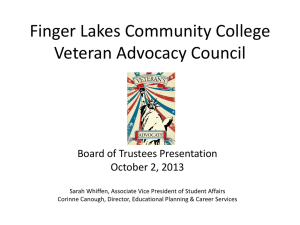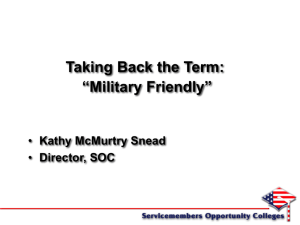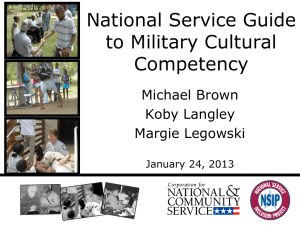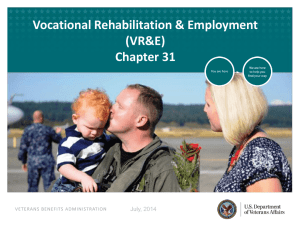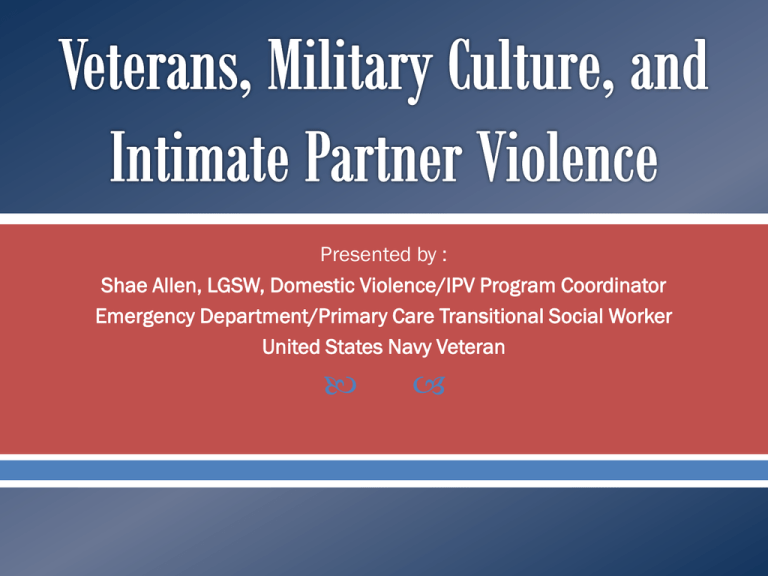
Presented by :
Shae Allen, LGSW, Domestic Violence/IPV Program Coordinator
Emergency Department/Primary Care Transitional Social Worker
United States Navy Veteran
1) Understand the Military/Veteran culture and potential correlation
within DV/IPV.
2) Learn to identify additional risk factors in screening for DV/IPV with
Veteran and Military families.
3) Gain understanding of deployment and combat related health
hazards and stressors to enhance current screening interventions.
4) Identify appropriate treatment and intervention strategies for
Veterans experiencing DV/IPV.
5) Learn to identify barriers to facilitating DV/IPV screenings and
interventions with Veterans, military members, and their families.
6) Gain overview of definitions and benefits associated with military
service and Veteran benefits to assist in comprehensive screening.
Diverse clients require diverse services.
As the delivery of a service becomes more population
specific, the service become more effective.
Developing a military/Veteran cultural competency can aid
in decreasing barriers that preclude effective interventions.
Allows us an opportunity to honor those who have honored
us with their service.
We will all work with Veteran populations.
Veterans can, and often do, correlate Veteran Healthcare
with community services.
Community providers often provide specialized treatment
that the Veterans Administration (VA) or Department of
Defense ( DoD) does not provide.
Many Veterans are not eligible for VA Health Care services,
or are not aware of their access to benefits. Community
providers play a vital role in enhancing services to Veterans.
Develop a basic understanding of the military branches and Veteran
services.
Learn to identify common stigma and barriers to care.
Learn to identify combat and service related disabilities, specific conditions,
and service member transitional concerns.
Understand how the personal beliefs of the service member or Veteran may
affect their perception of circumstances.
Recognize the role that family members and caregivers play in the lives of
service members and Veterans.
Become aware of how personal beliefs relating to military service, benefits,
and political concerns may affect the development of cultural competency.
Identify strategies to utilize competency to enhance services to family
members of service members and Veterans.
Learn to identify basic elements of military culture and service member
identity.
Identify Military and Veteran service terminology/definitions.
Military branches, instillations, and Veteran service providers
often operate independently, and differ in response and
intervention.
Community providers may often be unfamiliar with the military
and Veteran Health Care system.
Community advocates and providers play a unique role in sharing
expertise of local services, state laws and policies with Veteran
health care providers.
Community providers often are in a position to assist service
members, family members, and Veterans in accessing
comprehensive care.
Sharing training, education, and information will lay the
groundwork for developing a strong Community of Practice.
In December, 2013 the VHA finalized the “VHA Plan for Implementation
of the DV/IPV Assistance Program”.
o This included suggestions for developing a community of practice with
community service providers.
In 1999, Department of Defense created a Task Force on Domestic
Violence that included both military and community experts.
o Recommendations from this Task Force have been integrated throughout
military services.
o Recommendations have included an emphasis on strong civilian/military
partnership to prevent and assist with DV/IPV.
Many Military installations and VHA services continue to develop
practice methods and policies to include collaboration with community
service providers within the DV/IPV community.
Community providers can affect the services provided to our service
members and Veterans.
There were 435,657 projected Veterans residing in Maryland
during the year 2014.
450,000 Maryland veterans and their families are eligible to
utilize services provided by Maryland’s Commitment to Veterans.
According to the Department of Veterans Affairs, there are over
64,000 women veterans residing in Maryland.
http://servingtogetherproject.org/services/marylands-commitment-to-veterans-2/
We Will• Review DV/IPV services and response within the military
and Veteran community.
• Review barriers to accessing DV/IPV treatment within these
populations.
• Discuss service member/Veteran specific health care
concerns that may correlate with DV/IPV concerns.
• Identify appropriate treatment methods and intervention
strategies for Veterans who are using/experiencing DV/IPV.
• Discuss basic history and key elements of DV/IPV as it
relates to the Department of Defense, Veteran Health
Administration, and those who served.
IPV
Within Veteran and Military Populations:
o Basic core factors of DV/IPV are no different
o Characteristics of service, stigma, and military lifestyle can result in
unique risk factors
o Transitional and combat/deployment experience may exacerbate IPV, or
cause an increase in frequency of events
To
care for service members and Veterans
experiencing or using Intimate Partner Violence, it
is imperative to understand the culture of that
client.
The largest percentage of service members in each branch
serves on Active Duty.
Their service is full-time, whether deployed overseas or
domestically.
Active-duty service members receive a salary paycheck and
full benefits, including health care, housing allowance and
30 days of paid vacation per year.
They receive full healthcare and housing allowance for
spouses and dependents. Dependents of a spouse can also
receive healthcare benefits.
Each Service has a corresponding Reserve, and most states and
territories have an Army National Guard and Air National Guard unit.
Reserve members receive the same training as active-duty peers, but do so close to
home until deployed.
o Many hold full-time jobs or attend school full time in additional to service. Often all of
the above.
o
Army National Guard
o
Most U.S. states and territories have an Army National Guard unit. Both the president
and state governors can call on them as needed. They are sometimes deployed
internationally alongside full-time service members, but most often work in disaster
relief or other emergency situations within the United States.
Air National Guard
o
Like Army National Guard units, Air National Guard units are found in most U.S. states
and territories. Air National Guard members also have civilian jobs and train close to
home, although they can be deployed abroad. They receive the same training as their
active-duty counterparts, and their roles include defending the nation by air,
delivering aid following a natural disaster or providing emergency health care.
Branches of Service
Army – The oldest branch of the Military, the Army protects the
security of the United States and its resources.
Navy – The Navy defends the right to travel and trade freely on
the world’s oceans and protects national interests overseas.
Marine Corps – Working closely with the Navy, the Marine Corps
is often first on the ground in combat situations.
Air Force – The Air Force protects American interests at home
and abroad with a focus on air power.
Coast Guard – The Coast Guard is a military, multi-mission,
maritime service within the Department of Homeland Security. Its
core roles are to protect the public, the environment and U.S.
economic and security interests in any maritime region, including
international waters and America’s coasts, ports and inland
waterways.
Each Branch has its own primary mission, symbolism, and core
values.
Branches of service will share a focus on:
o Discipline/structure
o Pride in service
o Professional ethos of Loyalty
o Self-sacrifice
o Code of honor
o Focus on hierarchy and rank structure
o Emphasis on group cohesion
o Esprit de corps that connects service members and Veterans to each
other
The individual is secondary to the unit
Loyalty and Honor
Courage
Physical Challenge
Community/peer support
Recognition
College benefits
Income
Vocational training
Pride
Encouragement from teachers/recruiters/family members
Age requirements:
Physical health requirements:
Substance abuse history:
Mental health history:
Criminal history limitations:
A moral waiver is an action by United States armed officials to accept, for
induction into one of the military services, a recruit who is in one or more of a
list of otherwise disqualifying situations:
Adult felonies
Juvenile felonies that involved violence
Offenses involving the sale or transfer of illegal drugs
Sex offenses
Domestic violence that falls under the Lautenberg
Amendment:
o The 1996 Lautenberg Amendment to the Gun Control Act of 1968 makes it
unlawful for anyone who has been convicted of a misdemeanor of domestic
violence to possess firearms
The military and Veteran community has its own unique language
and terminology
Common Acronyms:
o SM-Service Member
o PTSD-Post Traumatic Stress Disorder
o TBI- Traumatic Brain Injury
o MST-Military Sexual Trauma
o DoD-Department of Defense
o VHA-Veterans Health Administration
o VBA-Veterans Benefit Administration
o OIF/OEF/OED-Combat periods that often refer to returning combat
Veterans
o SC-Service-Connected Disability
Use of language/acronyms may indicate services your client has
accessed, could potentially access, and identify possible risk
factors.
Individual service members, military branches, VHA,VBA, and
family or community members may inter-use terms and
definitions.
Terms may have different meanings within different contexts.
Learn to recognize terminology, and when to ask for clarification
on:
o What does this term means?
o What service/benefit your client is correlating the term to?
o Most importantly….What does the term mean to them?
What Does PTSD Mean:
To an active duty, deployed service member?
To a Vietnam Veteran?
To a recently returned combat Veteran?
To a spouse of a service member/Veteran?
To a community provider treating a service
member/Veteran for childhood trauma
To the Veterans Benefits Department?
To a Veterans Health Care Provider?
To a Community service provider?
Understanding The BattleMindset
Many strengths and skills developed during military service will
solidify a Veteran identity.
Many service members and Veterans have been significantly
trained in vigilance, resilience, and responsive behavior.
Aggression and hyper-vigilance are useful tools within military
service, but often translate into social and behavioral difficulties
when returning home.
Learn to assist your client in identifying behavior as a strength vs. a barrier
Battlemind is a framework developed by the military to
understand that the combat skills and mindset that
prepared service members for deployment and combat may
now negatively affect social and behavioral health at home.
Battlemind is the Soldier’s inner strength to face fear and
adversity in combat with courage.
Battlemind may become “hazardous” to social & behavioral
health in the home zone…
This relates to many aspects of service member transition,
but can have specifically have an impact on DV/IPV.
War Zone
Buddies (cohesion)
Accountability
Targeted Aggression
Tactical Awareness
Lethally Armed
VS.
Emotional Control
Mission Operational Security
(OPSEC)
Individual Responsibility
Non-Defensive (combat)
Driving
Discipline and Ordering
Home Zone
Withdrawal
Controlling
Inappropriate Aggression
Hypervigilance
“Locked and Loaded” at
Home
Anger/Detachment
Secretiveness
Guilt
Aggressive Driving
Conflict
You cant quit….even when it hurts
You cant call in sick, you can walk it off
If you are sick, you have to go to “sick call”
You will miss important family events, and your family will
be proud to support you
You will face danger
You will never leave a comrade behind
Belief that you:
o Never quit
o Never show pain
o Never give up
o Never give in
Learn to assist client in differentiating between
military/Veteran norms and common elements of IPV/DV
Within the Veteran and Military culture it is common for
someone to tell you:
o What to wear
o Wear to sleep
o Where to go
o Where to live
o Where you can go
o Who you can call
o What to eat
o When to eat
Each member has a mission.
That mission is….the needs of the “Army, Navy, Air Force…”
Focus on the mission and group survival, individual often
not considered.
Often stigma relating to identifying “individual” concerns.
o Physical pain
o Stress or depression
o Financial problems
This often translates into transitional concerns or barriers to
seeking care as a Veteran.
LGBT service members may present with complex barriers to
seeking care for a range of healthcare services, to include
DV/IPV.
Active Service LGBT members may face increased stigma, fear of
disclosure, and lack of support with other service members or
peer groups when disclosing or reporting IPV.
Transgendered individuals are prohibited from serving in the
United States Military if identified. However, many transgendered
individuals continue to serve. Fear of retribution can be a strong
barrier to seeking assistance given the contextual concerns.
“Don’t Ask, Don’t Tell”(DADT)
o A law and policy implemented since 1993 that provided that
homosexual conduct is a bar to service in the Armed Forces.
o Law was repealed in 2013, but continues to impact stigma.
As of 2011, there were estimated 203,000 female service members
In 2011, women made up 2.7% of the military's front-line units (2011 Department of
(2011 Department of Defense Demographic Report).
Defense Demographic Report).
Women were previously barred from the infantry, but were allowed to
serve on gun crews, air crews and in seamanship specialties.
Despite the prior ban on combat, women who served in Iraq and
Afghanistan often found themselves engaged in firefights
67 of the nearly 3,500 Americans lost in hostile fire in Iraq were female
service members.
Female service members experience unique concerns with:
o
o
o
o
Stigma and perceived barriers to care
Specific health care needs
Higher correlation risks with military sexual trauma than male service members
Unique risk factors with IPV
In 2013, the ban was lifted on women serving in combat.
Active duty women with 1 child or 3 or more children were 2 times more
likely to experience physical and/or sexual abuse than women in the
military with no children (Campbell et. al, 2003).
Prevalence rates of IPV experienced by active duty women varies
between 13.5-58% (Campbell et. al, 2003).
In the sample of active duty military women from the greater
Washington, DC metropolitan area, 29.9 percent reported adult lifetime
intimate partner violence, defined as physical and/or sexual assault
from a current or former intimate partner (Campbell et. Al, 2002).
Female service members are often fearful of reporting incidents due to
the lack of confidentiality and privacy as well as limited victim services.
Many female service members will seek community providers to
maintain privacy.
Reporting options
o (Restricted vs. Un-restricted)
Spouse/Family member concerns
Jurisdiction issues
Protection orders
“Restricted Reporting”
Give service member experiencing
violence time to receive information
and support before reporting.
Allows those to disclose details of
violence to authorized individuals
and/or receive medical attention
without starting a legal investigation.
The alleged offender’s Commander or
law enforcement is not made aware of
services.
Those authorized to receive a
Restricted Report are domestic abuse
victim advocates, the supervisor of
victim advocates or a healthcare
provider, including those on the Family
Advocacy Program.
“Un-Restricted Reporting”
Individual can access same services
as restricted reporting, but a legal
investigation is started.
Once there is an un-restricted report,
the individual cannot choose to revert
to restricted.
Commanders of both parties will be
notified, if applicable.
“Gun Ban for Individuals Convicted of a Misdemeanor Crime
of Domestic Violence,” Pub. L. 104-208, 18 U.S.C
Amendment bans access to firearms by individuals
convicted of crimes of domestic violence.
May require military member to be discharged or reassigned. Impact on strict reporting procedures relating to
DV/IPV and service members.
Often precludes family members from reporting DV/IPV, as
fear of loss of individual’s military service is a concern.
Soldiers & Sailors Civil Relief Act (SSCRA), legislation
designed to help ease the economic and legal burdens on
military personnel called to active duty status.
Can protect service members from attending court
hearings relating to custody, divorce, and civil proceedings.
http://www.bwjp.org/files/bwjp/files/SCRA_and_Protection
_Orders.pdf
Spouses and intimate partners often “hold down the home
front” as our service members deploy.
They often move frequently, become isolated, delay careers
and education, may be economically dependent, and share
children with the service members.
Veterans often strongly identify with their military service,
beliefs, and military values.
Military members and Veterans may be unable to identify
their transitional issues, or be aware of concerns.
Service members and Veterans may maintain pride
associated with why behaviors were developed, even during
negative outcomes.
It is important to be able to assist the Veteran in clarify the
different responses to these mindsets.
Learn to use the strengths that have been developed to
work through negative patterns of behavior.
Assist in decreasing stigma relating to seeking treatment.
Increase provider knowledge of obstacles/barriers to
reporting DV/IPV within military and Veteran populations.
Provide an understanding of the impact that military service
and Veteran benefits can indicate, as both a strength and a
barrier to seeking care.
Allow the provider to develop a stronger rapport with client,
and assist in comprehensive care coordination.
According to the 2010 US Census Data, there are 22,658
Million Veterans in the United States.
More that 1.3 Million of those Veterans have served in
multiple wars.
Veterans are at risk for unique concerns, such as combat
related PTSD, TBI, MST, transitional difficulties,
homelessness, and higher rates of divorce and DV/IPV
within certain populations.
“For the purposes of VA health benefits and services, a
person who served in the active military service and who
was discharged or released under conditions other than
dishonorable is a Veteran”.
Many Veteran services and benefits will correlate with
specific factors relating to individual service.
Veterans may not identify with Veteran services:
o I did not serve in combat
o I am not over 65
o Female Veteran services
Type of Discharge
Type of Punishment
Eligible for…
Not Eligible
Honorable
N/A
All benefits
N/A
General, Under Honorable
Conditions
Mandatory if drugs are
involved. Non-judicial
punishment.
Medical, compensation and
pension.
GI Bill (usually) and possibly
other benefits.
Other than Honorable
Convicted by civilian court.
Cannot re-enlist.
Some medical in some
cases.
Most benefits.
Bad Conduct
Court martial. Usually
involves confinement in
military prison.
Some Medical in some
situations
Most benefits.
Dishonorable
General court martial
(desertion, sexual assault,
murder). Can't own
firearms. May lose right to
vote.
None
In most cases-No Benefits
The DD Form 214, Certificate
of Release or Discharge from
Active Duty
Form is required to access VA
benefits, unless previously
utilized
If lost, new copy can be
requested via Veterans
Service Records through
National Archives. Can be
completed online or via paper
form SF-180
Example
DD-214
World War I (April 6, 1917 – November 11, 1918)
World War II (December 7, 1941 – December 31, 1946)
Korean conflict (June 27, 1950 – January 31, 1955)
Vietnam era (February 28, 1961 – May 7, 1975 for
Veterans who served in the Republic of Vietnam during that
period; otherwise August 5, 1964 – May 7, 1975)
Gulf War (August 2, 1990 – through a future date to be set
by law or Presidential Proclamation)
The Department of Veterans Affairs is comprised of :
Veteran Benefit Administration (VBA), Veteran Health Care
Administration (VHA), and National Cemetery Administration
(NCA).
Service members may use one benefit, and not have applied or
be eligible for another.
Enrollment in the VHA is not guarantee of VBA Benefits (Such as
service-connected disability).
Those with awarded service-connected disabilities or use of VBA
benefits, may have never utilized VHA services.
VHA and VBA do not always share record and chart systems, and
Veterans may be required to release information for correlation.
Provides benefits and services to Service Members, family
members, and Veterans, may include:
o Service-connected disability payments
o Education benefits
o Home loan eligibility
o Survivor benefits
o Vocational Rehabilitation programs
Minimum duty requirements are often determined in consideration with
discharge type, service-related disabilities, medical conditions, and
specific war-era contextual factors.
Veteran Healthcare services often include in-patient services,
outpatient services, specialty care, mental health treatment, and
substance abuse treatment.
Not every VHA will provide identical services, or have identical process
for accessing care.
Operation Enduring Freedom, Operation Iraqi Freedom,
Operation New Dawn (OIF/OEF/OND).
Developed to meet the needs of troop members returning
from recognized Global War on Terror Theaters of Combat or
countries in support of these efforts.
Allow for a transition from Department of Defense to
Veteran Health Administration.
Provides five free years of health care to eligible Veterans.
Provides case management services to allow for a
navigation of available health care and benefits.
Though the overall population of Veterans is decreasing,
there is a rapid increase in women Veterans
(Department of Veterans Affairs).
Women Veterans comprise 7.5 percent of the total Veteran
population and nearly 5.5 percent of all Veterans who use
VA health care services.
(Department of Veterans Affairs).
There are 26,574 women currently enrolled for care in VISN
5 (Many Maryland VA Health Care Facilities fall within this
VISN).
Gynecological and Breast Surgical Care clinics
Preventative care/Breast and Cervical cancer screening
Reproductive health contraceptives
Non VA Contracts for OB care
Fertility treatments (IUI)
Maternity tracking program directive
screening for IPV
SW tracking for psychosocial stressors during pregnancy
Prosthetics resources
Wigs for veterans with cancer or scalp conditions
Makeup for dermatological conditions
Maternity items, including breast pumps, nursing bras, etc.
Tele pharmacy—counseling for reproductive health, including teratogenic
concerns, as well as other pharmacological questions
Tele-health Case management
Among Women Veterans, the lifetime prevalence of IPV is 33%.
39% of women veterans report having experienced IPV, a rate
much higher than the national average.
Those who have experienced Military Sexual Trauma (MST) are at
an even higher risk for experiencing IPV (National Center for
PTSD).
Those who have served in the military, especially women, are at a
higher risk to experience IPV:
o Multiple deployments
o Family separation
o Exposure to physical and mental trauma while deployed (Gierisch, et. al)
“The Lesbian, Gay, Bisexual, and Transgender (LGBT) community is an integral
aspect of our human diversity. To that end, VA has implemented several policies
and programs over the last few years that specifically address the needs and
concerns of the LGBT community”
Males experiencing IPV have received little attention within
the health care field.
Federal and State laws recognizing same-sex partnership
often preclude accurate reporting or appropriate services.
The U.S. Department of Veterans Affairs Domestic Abuse
Fact Sheet states that "11% of women in homosexual
relationships and 23% of men in homosexual relationships
report being raped, physically assaulted, and/or stalked by
an intimate partner“.
“Don’t Ask, Don’t Tell” was repealed in 2013, but the
stigma of reporting IPV within LGBT populations remains a
barrier.
Veterans previously discharged dishonorably under “Don’t Ask, Don’t
Tell” were not eligible for VA Benefits. These Veterans can now request
services, but may be unaware of how to do so.
Previous military and Veteran service responses to LGBT populations
have been limited, and are often associated with lack of privacy.
Encourage service member or Veteran to contact a VA staff to review
benefits and services.
Review Advance Directive planning, to ensure appropriate partner or
desired partner has access to care. Review that Advance Directive
previously completed maintains safety.
Be aware of common “myths”
Be aware that Veteran with previous history or MST or IPV may be very
uncomfortable discussing past violence.
o Establish rapport.
o Understand the history.
o Develop a cohesive, care-coordination relationship, if the Veteran requests.
Many Veterans were discharged under previous law of
“Don’t Ask, Don’t Tell”, which often resulted in a range of
discharge categories outside of Honorable. This precluded
many for re-entry into service or accessing VA benefits.
Veterans facing this concern can request an upgrade on
their discharge to access benefits since repeal.
http://dd214.us/reference/DischargeUpgrade_Memo.pdf
Spouses/partners often experience the same cultural identity as
service members or Veterans.
Spouses/partners may provide primary caregiver services to
Veterans.
Spouses/Partners will often share the pride of military service,
and the transitional stressors.
Spouses/Partners of a Veteran or service member may often
identify IPV with combat, PTSD, or military service. They be
unaware of how to access assistance for the Veteran.
Spouses/Partners may be reluctant to report IPV due to financial
and benefit related contextual factors.
Spouses or Partners of service members and Veterans may fear
outcomes of reporting, or be unsure how to handle DV/IPV.
Domestic Violence/Intimate Partner Violence regarding
Veterans and the Veterans Healthcare Administration
response:
In May 2012, VA chartered the DV/IPV Task Force to develop a
national program.
The VHA Plan for Implementation of the DV/IPV Assistance
Program was finalized December 2013 and includes 14
recommendations.
Implementation of the plan across the VHA will expand screening,
prevention and intervention to Veterans and will strengthen
partnerships with community providers/resources.
Focus is on developing a culture of safety and adopting a holistic,
Veteran-centered psychosocial rehabilitation framework to inform
all facets of the national DV/IPV assistance program:
o “Veterans who experience DV/IPV” vs. “Victim” or “Survivor”
o “Veterans who use DV/IPV” vs. “Batterer” or “Abuser”
Domestic Violence: Though this term has historically referred to
intimate partner violence, it more accurately refers to any
violence or abuse that occurs within the “domestic sphere” or “at
home,” and may include child abuse, elder abuse, and other
types of interpersonal violence (Wallace 2004).
Intimate Partner Violence: “The term intimate partner violence
describes physical, sexual, or psychological harm or stalking
behavior by a current or former partner that occurs on a
continuum of frequency and severity ranging from emotional
abuse to chronic, severe battering or even death. It can occur
in heterosexual or same-sex relationships and does not require
sexual intimacy or cohabitation.” (CDC 2012).
Military culture contributes to forming the identity of the Veteran.
Veterans and service members may fear labels, stigma, and
often perceive treatment as a failure of mission.
Veteran were proud to serve, and may alternate between periods
of active duty service.
Identified barriers that may be realistic concerns:
o Position
o Promotion/Career
o Loss of access to weapons
o Security clearance
o Exposure(matters are not private)
o Economic factors
Understand increased risk factors with Veterans and service
members:
o Control of finances
o Isolation
o Lack of community or family support
o Sexual aggression
o Threat to report to command/security clearance/peers
o Using shame/guilt/blame when Veteran or service member desires
to seek medical or mental health treatment
o Access or familiarity with weapons is common
The majority of service members returning from combat do
not engage in intimate partner violence, however…
o Many will have adjustment and stress reactions
o Combat experience and military stressors can exacerbate or
increase the frequency/intensity of intimate partner violence
o The battle mindset can often turn minor incidents into overreactions
o Most combat Veterans will re-adjust successfully. Learn to identify
warning signs.
o DV/IPV can impact mental and physical health outcomes.
• Increase of depression, suicide, and substance use
Post-traumatic Stress Disorder (PTSD)
o PTSD is an often treatable condition that results from a traumatic
events. Symptoms include:
•
•
•
•
•
Intrusive bad memories or nightmares of the event
Avoiding events and locations that may “trigger” thoughts of the event
Hypervigilance and arousal
Sleep problems, irritability, anger, aggression, and fear
Aggression to multiple situations or individuals
Traumatic Brain Injury
Suicide
Depression
Substance Abuse
o Self-medicating
o Guilt/Shame
Not all Veterans experiencing PTSD will become violent.
Learn to identify the current pattern of behavior, along with
the relationship history/behavioral pattern before military
service or combat.
PTSD may increase the intensity of IPV or increase physical
aggression, or vice-versa.
Learn to review for a comprehensive history and specific
behaviors/patterns of behavior, if you believe this is a
concern.
In order to encourage appropriate assessments, ask:
o How is this different from previous behavior?
o What has changed?
o Were there incidents of IPV at any time in the past?
o Is specialized care required or a concern?
o Can I learn to assist in referrals and education?
o Are the behaviors “new”?
o What are behaviors outside of IPV related incidents?
If a Service Member or Veteran returns from combat with
complex health conditions, injuries, PTSD, and mental
health concerns, they are not treated by one individual
person. They are treated by a team of specialized providers
trained in Military/Veteran specific concerns and utilize
strong care-coordination.
If you believe that IPV is exacerbated or caused by a
transitional or combat related concern, comprehensive
screening and care coordination is recommended.
Thank Veterans and service members for their service.
Be aware of services and benefits that may provide specialized
treatment or unique resources.
Identify the role that the family member or caregiver may play.
Identify potential economic or legal concerns that may present a
barrier to requesting care.
Utilize office space to reflect openness:
o Military or Veteran posters/flyers
o VHA information or pamphlets
o Identification of common military observations (Veterans Day, Marine
Corps Birthday, Military spouse appreciation day, Military Sexual Assault
Awareness Month)
Do Not Assume :
o That combat was difficult, or that the military was difficult
• Many individuals will have enjoyed aspects of deployment and military
service.
o That every experience was the same.
o That every Veteran is “Broken”
o That a Veteran, service member, or family member will desire to leave
the relationship.
o That stigma or fears of repercussions are not real.
o That all Veteran IPV will be related to military or combat experience.
o That the service member or Veteran has support of their peers, such as
other:
• Women Veterans
• LGBT Veterans
• “Battle Buddies”
Do not assume the Veteran has not used VA services
because they are not eligible or do not desire to do so.
o Many Veterans are unaware of how to access services, or what
services they are eligible for.
Identify common locations of information on Veteran
eligibility and education, to assist Veteran in clarifying
questions.
Gain a release of information (ROI) if you will be assisting in
care-coordination. Familiarize with requirements of DoD
and VHA ROI requirements.
Integrate screening questions that will allow for specialized
care coordination
o Have you served in the military?
o Were you deployed or spouse/partner deployed?
o Have you accessed Veteran health care or benefits?
o Do you have a Veteran Health Care Primary Care Provider?
o Do you have a copy of your DD 214/medical records/ect…?
o What were your dates of service, combat era, ect…?
Veterans or service members may be in relationships with other
Veterans or service members, that may use or access the same
services.
The individual using IPV may have access to higher levels of
technology and security access.
o Be able to identify how this can increase safety concerns or stalking
behaviors
Individual using IPV may carry, have access to, or use threats of a
weapon.
o A Veteran or service member experiencing IPV may have the same.
o Clarify all weapons in the home, regardless of whom they may belong
to.
Individual using violence may be trained in hostage situations
and restraint.
Sudden increase of aggression or frequency of incidents of
IPV
A return from deployment or combat
Separations and reunions
Isolation of the individual experiencing violence
Financial dependency/healthcare dependency
Co-occurring health or mental health concerns (PTSD,
Depression, severe medical issues resulting from combat)
Do not fake knowledge, experience with services, or interest
in military experience, be genuine.
Be honest about lack of knowledge, and clarify why you are
asking additional questions.
Focus on the strengths that service members, Veterans,
and family members will have developed. Work together to
navigate system and integrate goal planning.
Do not assume all combat experience will result in PTSD, or
require mental health treatment.
Be direct, and validate their experience.
Be specific about your knowledge and available services.
Service members and Veterans are encouraged to complete an
Advance Directive at many points during service.
Screen for previously completed Advance Directives and financial power
of attorneys that may give privilege to the individual using violence
Determine if the Veteran uses online health care record systems.
Encourage changing passwords.
Review shared banking and financial accounts.
Review the caregiver role.
Understand stigma of reporting with a service member or veteran for:
• Aggression/assault
• Behavioral health concerns
• Suicidal behavior
Civilian lethality assessments often include:
o Does your partner have access to a gun
• A weapon is common with service members and Veterans, and may not
trigger the same fear response common in civilian populations.
o Have you lived apart from your partner in the last year
• This is not a sign of safety or lowered risk with active duty or Veteran
service members. Many live apart, and IPV can alter in form and
increase upon return.
o Is your partner unemployed
• Many Veterans will be unemployed following discharge, but may have
multiple financial resources that the spouse may not have access to.
As a Service Member or Veteran, would you:
o Report being sexually assaulted if all of your co-workers would be
o
o
o
o
aware?
Request to see a behavioral health provider if it would prevent
advancement?
Report a “minor” medical condition if you knew someone would
have to take your place on a mission?
Report being unable to prevent someone from attacking you, when
you are responsible for defending the person you are reporting to?
Report a spouse for physical assault, if you believed they would lose
their career?
• If you believed the IPV was related to combat service?
Establish rapport.
You may not be the one to treat the problem, but you may
be the one to open the door:
o Acknowledge military service, be willing to learn about clients
experience.
De-Stigmatize mental health care.
Learn to identify key department contacts within Veteran Affairs
Medical Centers.
o
o
o
o
o
Returning combat Veterans
Primary Care Provider
Homeless Services
Women's Health Services
Mental Health Services
Include a review of specialized risk factors within basic
assessments:
o
o
o
o
o
Combat exposure, blast exposure
Military Sexual Assault
Re-adjustment issues relating to service, length of time since discharge
Sleep disturbances, alcohol/substance use, symptoms of PTSD
Suicidal Ideation
You do not have to memorize each service and benefit to
assist a Veteran or Service Member.
Learn simple questions to ask, and be honest about what
information you can identify together.
Focus on strengths and achievements.
A simple way to open the door to conversation is to thank
them for their service!
o This includes spouses and partners. Family members serve!
For Enhancing Services to our United States
Veterans and Service Members
Jennifer Broomfield, LISW, JD
National Program Manager, DV/IPV Assistance Program
Jennifer.Broomfield@va.gov
Shae Allen, MSW, LGSW
VA Maryland Healthcare System
Domestic Violence/IPV Program Coordinator
Shaundra.Allen@va.gov
Centers for Disease Control and Prevention (2014, March 11). Intimate Partner Violence: Definitions. Retrieved from
http://www.cdc.gov/violenceprevention/intimatepartnerviolence/definitions.html
Marshall, A. et al. (2005) Intimate Partner Violence Among Military Veterans and Active Duty Servicemen, Clinical Psychology Review, (25) 862-876.
Centers for Disease Control and Prevention (2014, March 11). Intimate Partner Violence: Definitions. Retrieved from
http://www.cdc.gov/violenceprevention/intimatepartnerviolence/definitions.html
Johnson, M. (2008). A typology of domestic violence: Intimate terrorism, violent resistance, and situational couple violence. Lebanon, NH: Northeastern University Press.
Wallace, H. (2004). Family Violence: Legal, Medical and Social Perspectives. Allyn & Bacon.
Wenger-Trayner Website (2014 March 11) Retrieved from http://wengertrayner.com/resources/what-is-a-community-of-practice
Luby, C. (2010) Promoting Military Cultural Awareness in an Off-post Community of Behavioral Health and Social Support Service Providers
Department of Defense Task Force Against Domestic Violence. Retrieved from http://www.defense.gov/releases/release.aspx?releaseid=2367
LGBT Veterans Health Care Fact Sheet (2014)
U.S. Department of Veterans Affairs Domestic Abuse Fact Sheet
http://www.militaryonesource.mil/12038/MOS/Reports/2011_Demographics_Report.pdf
http://www.census.gov/compendia/statab/2012/tables/12s0521.pdf
http://vaww.infoshare.va.gov/sites/LGBEducation/default.aspx
Centers for Disease Control:
http://www.cdc.gov/violenceprevention/intimatepartnerviolence/index.html
Futures without Violence: http://www.futureswithoutviolence.org/
Motivational Interviewing with Individuals Experiencing IPV:
o
o
o
http://www.youtube.com/watch?v=P3JUXQ4kkHs&list=PL5A76222400692548&index=2
http://www.youtube.com/watch?v=lrnkEQRUyJM&index=3&list=PL5A76222400692548
http://www.youtube.com/watch?v=jxNBQKMW1wg&index=4&list=PL5A76222400692548
National Domestic Violence Hotline: http://www.thehotline.org/ (this website also
lists contact information for State Coalitions and LGBT resources).
Simmons College – School of Social Work Self-Paced Domestic Violence Training:
o
http://www.simmons.edu/ssw/academics/professional/online/domestic-violencetraining/index.php
•
Veterans Affairs – Women Veterans Health Care:
Victim Advocate Guide:
http://www.bwjp.org/files/bwjp/articles/Victim_Advocate_Guide.pdf.
http://www.womenshealth.va.gov/WOMENSHEALTH/outreachmaterials/abuseandviolence/intimatepar
tnerviolence.asp


